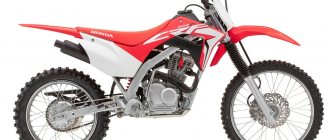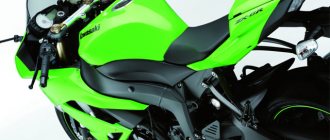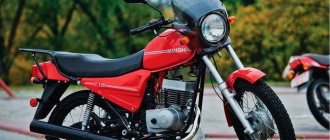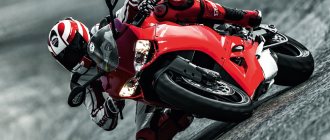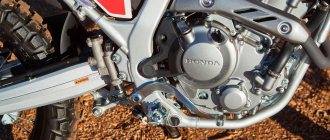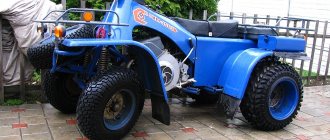Time flies inexorably forward, and no one can stop it. Technical progress flies along with it, and now a new Minsk motorcycle, or rather a new model of it, has been presented to numerous motorcyclists Minsk R250.
This miracle of technology was manufactured at a Belarusian factory and is an exact copy of a product of the British motorcycle industry - the magnificent Megelli 250R motorcycle. The difference between them is very insignificant and lies only in the stickers, which are slightly different on the Belarusian motorbike, naturally. The new Minsk model will be sold on the Belarusian market and not only on it.
New motorcycle Minsk - promotion in the motorcycle market
After the Belarusians established production and the new Minsk motorcycles slowly began to gain popularity, representatives of the Minsk-Moto company immediately announced that this motorbike model would be sold in different countries under two brands - Minsk and Megelli.
As already reported above, these models are practically no different from each other, but the difference in price is quite significant. If Minsk on the CIS market can be purchased for three thousand seven hundred dollars, then its analog Megelli costs no less than five thousand dollars.
Reviews from Minsk R 250 owners
I bought a Minsk R250 motorcycle secondhand in 2016 with a mileage of 3600 km. I immediately fell in love with the appearance, it somehow reminds me of Ducati. It's comfortable to sit (height 171). On the first trip I pressed the brakes and almost fell apart, they are really tenacious, and the bike itself is light. The dynamics for 250cc are normal, but the gears have to be clicked often. I can’t say anything about the standard tires; I changed them immediately after purchase, they had already become stiff from age. We have all the consumables, everything is cheap, and it doesn’t break the bank. The quality of the plastic and paintwork is disappointing; once I touched the bike slightly on its side, not too much at all, but the fairing cracked. Evgeniy, Volgodonsk, Minsk R250 '2015
The motorcycle is worth the money. You can't expect racing records from it, but it accelerates well and brakes well. and it is generally steered by an effort of thought. The seating position is a little uncomfortable, your arms get numb, but it’s still a sportbike, so it’s forgivable. Wind protection is normal, but the P250 was clearly not blown through in the Minsk wind tunnel - after 120-130 km/h the flow breaks down from somewhere, and the wind starts hitting the helmet from below. In a strong headwind it is even more noticeable. Alexander, Moscow, Minsk R 250 '2017
The motorcycle is so-so, it rides like a vegetable, although it looks cool. Acceleration is sluggish, the seat is oak, and the standard tires are garbage. The plastic is scratchy, if you dropped the bike, go get a new body kit. The pluses are appearance, brakes and price, the minuses are dynamics and reliability. Ilya, Brest, Minsk R250 '2016
Technical characteristics - motorcycle Minsk R250
This model may slightly scare off a potential buyer due to the size of the tires, which make it unsafe to travel on domestic roads at super speeds. The ergonomics of the motorcycle also raises some complaints, the clip-ons on the tank are especially alarming.
This motorbike has a fairly rigid chassis, thanks to which its behavior when cornering can be called aggressive. The thing is that it was assembled not by the Chinese, but by native Belarusians. It is a pity that it did not occur to them to somewhat improve and modernize the unit, and everything was limited to copying it. The rigid chassis of the motorcycle, which consists of an aluminum spatial pendulum and a steel cage, turns it into a real aggressor while riding. Externally, the Minsk R250 resembles a Japanese motorbike.
The disadvantages of this model include:
- a hard and uncomfortable seat that greatly reduces the authority of this motorcycle;
- Too sharp edges of the fairing create inconvenience for the motorcyclist.
Pros and cons of the Minsk R 250
Advantages
- Affordable price
- Interesting design , modern but not too pretentious
- Peppy dynamics for a 250cc motorcycle
- Efficient brakes
- Undemanding to fuel quality - the motorcycle can run on AI-92
- Excellent maneuverability
- Good suspension with telescopic upside-down fork
- Decent wind protection at any speed available to the bike
Flaws
- Uncomfortable passenger seat
- Poor visibility in standard mirrors
- Fragile plastic body kit
- Short service intervals
- The quality of spare parts , according to reviews, sometimes leaves much to be desired
Test drive of the Minsk R250 motorcycle
The Minsk R 250 motorcycle is equipped with a non-adjustable fork and shock absorber made in Taiwan. Everything works quite well on the track
The bike doesn't wobble or jerk. Although if you race it along the domestic off-road at full speed, you can feel some shocks in your arms and in the “fifth point”.
The clip-ons, which were inherited from the Megelli 250R, do not interfere on the road, but may turn out to be somewhat unnecessary on city roads, with frequent turns of the steering wheel left and right. The problem can be fixed - you need to replace the clip-ons with shorter ones.
The new Minsk motorcycle is equipped with good brakes and petal discs. The calipers are a bit harsh. This motorcycle model is designed for traveling at high speeds; a speed of 60 km per hour is not for it. That is why you should not skimp when installing new tires; it is better to choose more expensive and high-quality models, which will increase the safety of the biker.
The main result is that the motorcycle is simply wonderful, especially considering its price, which easily compensates for minor and few shortcomings.
Test drive Megelli250 R
Before starting to get acquainted with the motorcycle, I will introduce you to a new brand on the Ukrainian and world market - Megelli. The project was created by the British company SLD UK and turned out to be international. It all started in 2005 with the first sketches, which depicted something openwork placed on two wheels. Well, just think, they drew pictures - that’s often where it all ends. But... it's not over. In 2007, the first production samples were released. Apparently, someone from the initiative group managed to interest Chinese and Taiwanese investors in their project. As a result, the motorcycle turned out to be truly transnational: it has a British ideology, Italian design, Taiwanese components and Chinese assembly. And, of course, German quality - what would we do without it?
Motorcycles of a new and unfamiliar brand appeared in Ukraine quite recently. If you compare them with French buns that are baked in the suburbs of Paris, then these stories have not yet had time to cool down. Well, we were glad to “taste” them first.
Our test subject is the Megelli 250R sportbike. And don’t turn your noses up, owners of Japanese “bullets”! In terms of chassis, this bike is much closer to sports than some “liters”. Initially, the heart of the motorcycle was a 125 cc Taiwanese air-cooled SYM engine, but now it has been replaced by a 250 “water cooler”, designed by the Piaggio Group (but produced there, in Taiwan). The engine is contained in a powerful frame consisting of a cast aluminum rear section and a tubular steel front section. This magnificence is accompanied by a powerful pendulum, which is a structure made of aluminum tubes. The monoshock absorber and telescopic front fork with a 38 mm diameter of stays even look somewhat faded against the backdrop of the openwork “skeleton”, but they still perform their functions. When the designers were “sculpting” the aerodynamic body kit, it seemed like they had a calendar with a Ducati 1098R hanging above their desk. The similarity can be seen in the lines of the tail, the peculiar “look” of the front optics, and in the shape of the lower plastic. Perhaps the design is the 250R's strongest and most striking aspect.
This motorcycle is even visually light. Approaching him from the side, and taking hold of the steering wheel, I lifted the front end into the air without much effort. Its dry weight (without battery and fluids) is only 128.5 kg. All elements look good not only at dusk and in the distance, but also up close in bright light. The plastic joints, fasteners, remote controls, handles, releases, etc. are made almost flawlessly. You should have seen the standard set of tools! Even the world's top bike manufacturers will envy this. Definitely respect! But to whom: the British, Italians, Taiwanese or Chinese?
The test route started from the Lukyanovskaya metro station and ended at the roundabouts of the Boryspil highway. The key is to start, I press the start button... And my slight surprise begins to turn into complete awesomeness - the whole sporty Megelli 250R sounds like an ATV! The sound is deep, cutting, and quite pleasant. If something like this starts up behind you, then when you turn around, you secretly expect to see at least an enduro, but certainly not a sportbike. Just because of this feature alone, he will be provided with a lot of attention “in the crowd.”
The fit matches the appearance – sporty. It assumes a fetal-lying position of the pilot, which is only appropriate on the track. When driving around the city, you have to hang over the motorcycle, resting your hands on the handlebars. This is wrong, because in this case the forelimbs begin to get tired very quickly, and control accuracy is lost. It would be reasonable to wrap your knees around the tank and transfer your weight to it, but... it’s inconvenient to do this - the stampings of the side plastic cut into your legs.
Having glanced at the fully functional dashboard with a digital speedometer and analogue tachometer, I put it in first gear and start towards Naberezhnoe Highway. While I was squeezing my way to the first traffic light, I noticed that the checkpoint was working quite well. The only drawback I noticed was the difficult search for neutral, which remained the only one in relation to this unit for the entire test day. Although, an allowance should be made for the fact that the gearbox might not have had time to break in, because at the time the test began, the motorcycle’s mileage was less than 50 km.
The extremely sporty landing turned out to be expectedly uncomfortable in the city. It seems that even the toggle switches on the steering wheel were installed with the expectation that the pilot would be lying on the tank. For example, in order to turn the direction indicators on and off without straining, you need to either bend over or have an additional joint on your left thumb. The beautiful and readable tachometer worked very strangely while driving - the needle either moved along the scale in increments of 500 rpm, or even started dancing wildly. Later it turned out that other bikes in this series did not suffer from this disease. Most likely, the problem was with an incorrectly attached induction sensor. Yes, by the way, since I started talking about the bad, I’ll say my “fe!” and regarding mirrors. They, like the remote controls, were designed based on the pilot’s supine position, so during normal city driving you can’t see anything except your own elbows.
The engine, both for its size and origin, is quite good. This “quarter liter”, thanks to the short first gear, pulls smoothly and confidently from the very bottom, and loses enthusiasm only when the tachometer needle begins to approach the red zone. The bike does not demonstrate amazing acceleration dynamics, and the asphalt under the rear wheel does not fold into folds. And why? There are other motorcycles, capacities and prices for this.
It seems that it was not for nothing that this motorcycle was driven head and shoulders by factory pilots - the handling turned out to be almost standard. The Megelli 250R is completely under the control of the pilot, obeying his every movement. You sneezed and you were already driving in the other direction. I believe the reason for this is the low weight of the bike, because “sausage”, an indirect indicator of extreme steering geometry, was not observed throughout the entire test. If you ignore the awkward seating position in the city, this motorcycle is very good for tearing through everyday traffic. Judge for yourself: it is light, compact, responsive and dynamic. The large turn of the steering wheel and the short wheelbase allow you to get through where a “liter” would instantly get stuck. True, one “jamb” has surfaced here. When the steering wheel is turned completely to the left, the button for turning off the turn signals rests against the side trim on the tank, and the rider’s fingers lying on the brake lever are pressed against the edge of the windshield plastic. In principle, this can be eliminated in 15 minutes by welding on the limiter, but it’s still unpleasant - didn’t the factory testers notice this?
During the preliminary inspection, I paid due attention to the brakes. At the front there is a two-piston caliper, which is paired with a 300 mm wave brake disc and a reinforced hose. At the rear, of course, the kit is simpler - a 240 mm disc and a single-piston caliper. At first I had doubts about how such a set would handle a more than 200-kilogram crew from a speed of 150 km/h. Until the brake pads got used to it, everything was quite expected - informative, but not at all effective. But then the system began to demonstrate remarkable performance - a light touch on the right lever alone was enough for the bike to begin to noticeably lose speed.
Here is the farthest point of the route - roundabouts. Cutting loops on good asphalt, I gradually began to understand why this motorcycle was created. The race track is his most natural habitat. The Megelli 250R is a great entry-level track bike. When I bent down to the tank, all the remote controls and knobs instantly fell into place, and a good view appeared in the mirrors. The rigid chassis cut trajectories with razor precision, and the standard suspension calibrations seemed to me very successful for such operating conditions. The motorcycle did not rock, and the wheels clearly followed the gentle “landforms”, constantly being in contact with the asphalt. True, when hitting more noticeable irregularities, a slight drift was felt - the suspension did not have time to handle them. The same thing was observed when braking on wavy asphalt. Since the front fork is not adjustable, and it is impossible to release the hydraulics on rebound, I would recommend adding thinner oil.
Thanks to the compactness of the motorcycle, it is very convenient to hang from it when turning. Moreover, this situation does not bother the pilot at all. You can accelerate while leaning without fear of catching a highside - thanks to the smooth power characteristics of the engine and... an excessively long-stroke throttle handle. To fully open the throttle, you need to make a standard movement with your right hand, then grab the gas, and turn the remaining half knobs. I believe that in this way the manufacturer insured novice riders.
Full of positive thoughts, I slow down after the straight and enter the left turn. Suddenly, from under the motorcycle there is the sound of metal rubbing against the asphalt... What the hell? It's still a long way to the bottom! Having stopped, I noticed something that I had missed earlier - the side stand protrudes too much to the side, and clings to the asphalt in far from extreme slopes. Looking ahead, I’ll say that a couple of days after the test, SvitMoto, the official importer of Megelli, made sure that the stand stops on all 250Rs were shortened by 8-10 mm. Such efficiency inspires respect, but it becomes completely unclear to me where the factory testers were looking when the bike was just launched into production?
On the way back, I found the answer to the most pressing question - “how fast is it going?” It turned out that the Megelli 250R quite quickly reaches 120 km/h, confidently accelerates to 130, creeps up to 140, and eventually shows the pilot the number “150” on the digital speedometer. For a “quarter liter” this is a very decent indicator!
So, the overall picture gradually emerged. Some may think that I am too picky about the motorcycle. But the proverb “hitting means loving” has not yet been canceled... I am sincerely glad that the Taiwanese-Chinese (let’s face the facts) motorcycle for the first time invaded the territory of “small-sized sports”. Territory firmly occupied by the Japanese and Italians. That is, the game started in earnest? And if so, then the demand is mature. Considering that Megelli 250R is one of the first samples of a young company, then we have to admit that this is a very successful test! After all, it will be enough to repack the fork, install a short-throw throttle, put racing slicks on the wheels, and the raw model will turn into an excellent entry-level training bike. In order to have fun and hone your skills on the track, you don’t need high power and cosmic speeds. And if someone points a finger at the same Aprilia RS125 or RS250, then I will point with the same gesture at the price tag of the Megelli 250R. There's nothing to cover, right?
Text: Sergey Kuznetsov
Photo: Yuliy Radchenko
Video: Motorcycle Minsk R250
Related materials:
- Motorcycle tuning Minsk - appearance and engine transformation A person lives in society and, being among friends and relatives, is often guided by their opinions when making various decisions. With another …
- Chinese sports motorcycles - should we take them seriously? Nowadays, the inscription “Made in China” can be found on various products. Wardrobe items, household appliances, appliances, various tools and more...
- What is the best way to choose a motorcycle? It often happens that people resort to purchasing a vehicle only after obtaining a license, so what is important to know when choosing a motorcycle? ...
- Honda cb 400 motorcycle - quality proven over the years The Honda CB 400 motorcycle appeared on the Japanese market in 1992, replacing the well-known CB-1 model. Although their concept was the same, the SV400...
- Dnepr motorcycle - tuning an unfading heavyweight Back in 1997, the owner of a Dnepr motorcycle was practically the king of the road. And for good reason. After all, the Dnepr Motorcycle, the tuning of which requires the presence of...
Summary
When buying an inexpensive small-capacity motorcycle, you shouldn’t expect it to snatch stars from the sky. At the same time, even budget bikes are sometimes overpriced, and they are not cheap to maintain. This is why the Minsk R250 stands out among other light sportbikes - it is definitely worth all the money they ask for it. The amount sufficient to buy a new Minsk R 250 requires either Chinese motorcycles of questionable quality or heavily used Japanese ones. What you prefer is, of course, up to you, but it’s probably still worth considering the new R250.
Specifications
| Maximum engine power: | 26 hp at 8500 rpm HP |
| Working volume: | 249.5 cm3 |
| Motor type (cylinder arrangement, number of strokes): | 1-cylinder, 4-stroke |
| Number of cylinders: | 1 |
| Number of valves: | |
| Intake type (Injector / Carburetor): | |
| Bore and stroke: | |
| Starting system (Electric starter, kick starter): | |
| Maximum speed in km/h: | 145 km/h |
| Cooling system: | Liquid |
| Transmission (gearbox): | Mechanical 6-speed |
| Clutch (Dry / Wet): | |
| Drive unit: | Chain |
| Frame: | Steel tubular |
| Chassis | |
| Suspension (front/rear travel): | |
| Brakes (Front/Rear): | |
| Wheels / Tires / Rubber: | |
| Dimensions and weight | |
| Dimensions (Length / Width): | |
| Seat height: | |
| Ground clearance: | |
| Curb weight: | |
| Wheelbase: | 1350 mm |
| Weight: | 123 kg |
| Fuel tank capacity: | 11 l. |
| Battery capacity: | |
| Year of release: | |
| Country of Origin: |

